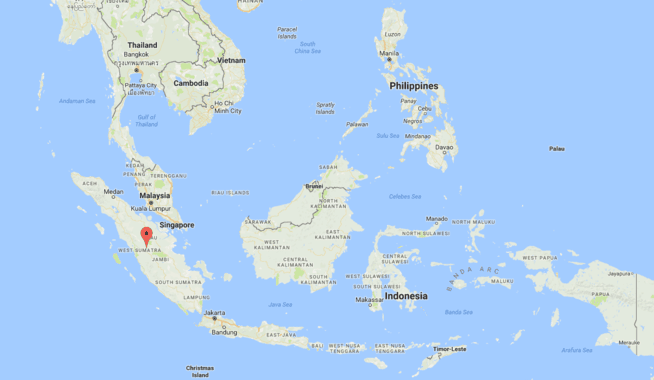
Is it its intense flavor? Perhaps the way it’s harvested?
What about the country, does that play a factored from where it is grown?
In Sumatra, their unique tasting coffee is attributed to many different factors. Their low acidity and complex flavor profiles have made coffee from this region special and highly sought after in the coffee world.
Let’s dive in and teach you everything you need to know about Sumatra and its coffees.
Where Does Sumatra Coffee Beans Come From?
Sumatra Coffee is grown the Sunda Islands. The Sunda Islands are a group of islands along the coast of Western Indonesia. Sumatra island (Sumatera in Indonesia), is the largest one in the group, the coffee grown in this region picked up its name.

Sumatra, Indonesia
The Sunda Islands are situated in the heart of the so-called coffee green belt. Its tropical weather, together with the hot and humid weather, creates some of the best coffee in the world.
Sumatran Beans Facts & Figures
- Growing Regions: ACEH, Lin Tong, Southwest Region, Lampung
- Process: Giling Basha (also known as wet-hulling)
- Altitude Grown: 800 – 1500m above sea level
- Common Varieties (Arabica Coffee): Typica, Caturra, Bourbon, S-Line Hydrids, Tim Tim
- Flavor Profile: Heavy body, sweet cedar, bell pepper, and distinct notes of chocolate, earthy, and balsamic vinegar
What Makes Sumatran Coffee So Special?
Sumatran coffee is truly special. Compared to South America or East Africa, it’s processed differently. As such, it has a unique taste and a profile of chocolatey and earthy flavors.
Small Farms And Cooperatives For Distribution
Check out this video that discusses the Sumatra coffee production and trade processes:
Specialty coffee in Sumatra are typically grown in small-holder farms in North Sumatra by Toba Batak people. These farms are usually small areas of land with a handful of trees farmed by families who can own as little as 100 coffee trees to a few acres of land. Coffee farms in North Sumatra and surrounding regions typically work together in structured cooperative partnerships, which allows them to sell their products together and split the profits evenly between them.
Typically, a cooperative in Indonesia contains anywhere between 20 – 1200 members, where they’re required to follow strict coffee processing guidelines and workplace requirements. Some cooperatives will even share knowledge and help strengthen their group’s position by helping smaller farms improve their technology and processes.
Overall, cooperatives allow smaller farms to meet market demands and make sure they continue producing coffee next year.
Another reason that makes Sumatran coffee unique is the way they’re harvested. Normally, Sumatran coffee uses a natural processing method called wet-hull, or Giling Basah in the Bahasa language.
Wet-hulling is one of many methods used to dry coffee beans. The beans we know and love start off as seeds that’re removed from coffee cherries. As you might imagine from fruits, they’ll be wet.
Typically, in other coffee producing countries, they’re left to dry until there’s 11% moisture content left before they’re processed in some other way. However, due to Sumatra’s volatile weather, farmers only have around 4 hours a day of drying time before the rain starts pouring in and potentially ruining all their hard work.
To get past this problem, the coffee beans are only left to dry till they reach 50% moisture content. They’re then sold/transported to a specialized wet-hulling machine that uses friction to complete the drying process and remove the coffee beans from its protective coating (known as the parchment). While this happens, the machine helps ferment the coffee beans and create a complex earthy flavor.
Want to learn more about Sumatra’s wet-hulling process? Watch this video here:
What Does Sumatran Coffee Taste Like?
Due to excess moisture, coffee from Sumatra varies greatly in flavor itself and drastically different compared to other countries. Sumatran coffee beans tend to have a lower brightness and acidity, and focuses more on muted earth tasting notes.
These tasting notes can include:
- Wild Mushroom
- Bell Pepper
- Balsamic Vinegar
- Peat/Moss
- Herbaceous
- Spicy Herbs
In other countries, organic coffee with earthy and vegetable notes are considered bad. It normally an error has occurred somewhere in the process and as such, lower quality.
However, in the realm of Sumatran coffee, this flavor profile is not dirty or wrong. Instead, people compare the unique taste and intensity to high-end scotch. It’s full of moss and peat flavor, there is a complexity in the flavors that make it very delightful to enjoy.
As mentioned earlier, coffee grown in Sumatra contains high moisture levels. Therefore, it’ll continue to ferment during storage and all the way up to before roasting. The fermentation will help develop the dynamic flavors above. When drinking Sumatra coffee, the complexity of it will create a unique tasting experience.
If you’re a coffee drinker who’s interested in trying this unique flavor, here are some options to try:
Since we’re talking about coffee from Sumatra and Indonesia, how can we not talk about the famous Kopi Luwak!
What is Kopi Luwak?
Kopi Luwak is another interesting coffee that’s unique to the Sumatra islands. Kopi Luwak is known as ‘the most expensive coffee in the world‘, and for a good reason. This type of coffee is produced in one of the most unusual ways you’ll ever hear.
Kopi Luwak refers to the unique process where palm civet cats eat and poop out coffee cherries. During this process, the seeds inside the coffee cherries are typically fermented and protected by a parchment layer.

Just in case you don’t know what Civet Cats look like…
The farmers’ main job is to find and collect cat poop, where they’ll extract, clean, and process the coffee beans from inside. Once this is all done, it’ll be ready for distribution.
Kopi Luwak exhibits an earthy tone that’s similar to mushroom and tomato. This complex taste is the result of the acid from palm civet cat’s stomach and the wet-hulling process, which ferments the coffee beans.
The distinct flavor notes also help increase the coffee price points. Along with high demand and little supply. Kopi Luwak can get around $100 or more per pound.
If it’s Wild Kopi Luwak, it’ll cost even more. This is where farms will go around searching for wild civet cats and their feces. It takes ages to collect enough beans for full-on coffee production. That’s why Kopi Luwak is one of the most premium coffee in the market, that’s why they’re super expensive!
Try Wild Kopi Luwak for yourself here: Wild Kopi Luwak Sumatra Lintong Coffee
The Coffee Barrister's Verdict [CONCLUSION]
As you can see, Sumatran coffee is highly sought after in the coffee world because of its unique earthy flavor profiles. The coffee is very different from coffee beans from other parts of the world. It’s a nice reprieve from the standard coffee flavors. The earth tones and low acidity can be off-putting for some but, if prepared, can provide a complex and pleasant drinking experience.
What do you think of Sumatran coffees, like them or hate them?
What about Kopi Luwak? What do you think of their unique harvesting method?
Are there any other coffee regions you want us to talk about?
Let us know in the comments below.
- To produce this coffee, coffee berries are eaten by the Luwak cat. In the stomach of these animals,...
- Noticeably not bitter, Kaya Kopi Luwak is intensely aromatic with a complex flavor profile that is...
- Kaya Kopi Luwak starts it life at 4,000 feet (1,200 M) above sea level in the heart of the...





